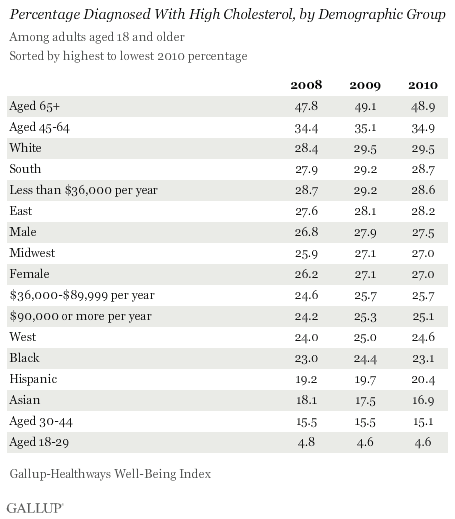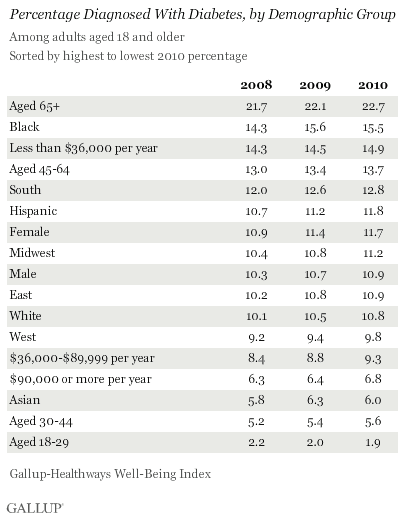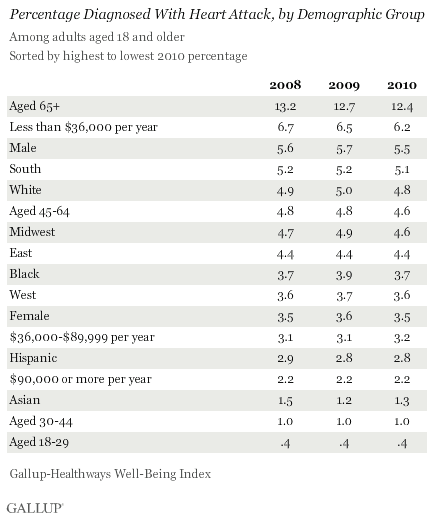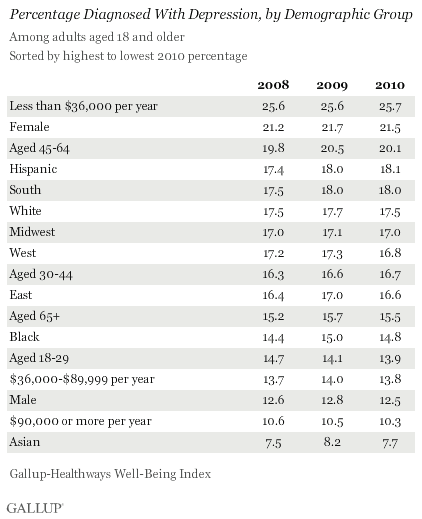WASHINGTON, D.C. -- American adults were as likely in 2010 as they were in 2009 to say they have ever been diagnosed with high blood pressure, high cholesterol, depression, asthma, diabetes, cancer, and heart attack, revealing that the country as a whole has made no progress in decreasing these costly chronic conditions. About 3 in 10 American adults continue to report having been diagnosed with high blood pressure or high cholesterol in their lifetimes, making these two illnesses the most widespread diseases measured. The prevalence of diagnoses of high blood pressure, high cholesterol, diabetes, and cancer is up compared with 2008.

These data are in line with Gallup's finding that obesity -- which is linked to a number of chronic diseases including diabetes and high blood pressure -- did not increase significantly last year compared with 2009, although it remains a major problem.
Gallup tracks chronic conditions in the United States on a daily basis as part of the Gallup-Healthways Well-Being Index, surveying more than 350,000 American adults per year. Gallup asks respondents if a physician or nurse has ever diagnosed them with any of the conditions.
High-Risk Populations
Some groups are more at risk for having certain health conditions, likely for a number of reasons. Income, health habits such as exercise and healthy eating, age, and genetic predisposition all relate to whether individuals have chronic conditions. For example, previous Gallup research has found that low-income Americans, regardless of age, have worse emotional and physical health, health habits, and access to healthcare than do those with higher incomes. A closer look at the 2010 Gallup data reveals:
-
Seniors (58.7%) and black Americans (38.7%) are the groups most likely to report high blood pressure.
-
Americans 45 years of age and older are among the most likely to report high cholesterol.
-
One in four low-income Americans reports having been diagnosed with depression, which is more than any other group.
-
Asthma is most prevalent among low-income Americans (14.6%), women (13.7%), young adults (13.4%), and blacks (13.2%).
-
The percentage of seniors who have diabetes (22.7%) is double the national average (11.3%). Blacks are the second most likely group to report diabetes (15.5%).
-
Nearly 2 in 10 seniors have been diagnosed with cancer.
-
Seniors (12.2%) and low-income Americans (6.2%) are the most likely to have had a heart attack.

Top Performers
Three groups stand out as being in the best health: Asian Americans, high-income Americans, and young adults. While differences by age and income are more easily explainable, reasons for Asian Americans' better physical health are not as straightforward. At every major age and income level, Asian Americans have a lower prevalence of most of the chronic conditions than do whites, blacks, and Hispanics.
-
Asian Americans and young adults are the least likely to report high blood pressure.
-
Americans aged 18 to 44 are the least likely to report high cholesterol.
-
High-income Americans (10.3%) and Asian Americans (7.7%) are among the least likely to report having been diagnosed with depression.
-
Asthma is least prevalent among high-income Americans (9.3%), men (9.2%), and Asian Americans (7.3%).
-
At 1.9%, young adults are the least likely to report diabetes, although this jumps up to 5.6% among those aged 30 to 44.
-
Fewer than 2% of Asian Americans and young adults report a cancer diagnosis.
-
Americans younger than 44 years of age, Asian Americans, and high-income Americans report a heart attack diagnoses at less than half the national average.
To view chronic condition prevalence by demographic groups by year, see page 2.
About the Gallup-Healthways Well-Being Index
The Gallup-Healthways Well-Being Index tracks U.S. well-being and provides best-in-class solutions for a healthier world. To learn more, please visit well-beingindex.com.
Survey Methods
Results are based on telephone interviews conducted as part of the Gallup-Healthways Well-Being Index survey Jan. 1-Dec. 31, 2010, with a random sample of 352,840 adults, aged 18 and older, living in all 50 U.S. states and the District of Columbia, selected using random-digit-dial sampling.
For results based on the total sample of national adults, one can say with 95% confidence that the maximum margin of sampling error is ±1 percentage point.
For results based on subgroups, one can say with 95% confidence that the maximum margin of sampling error is ±1 percentage point.
Interviews are conducted with respondents on landline telephones and cellular phones, with interviews conducted in Spanish for respondents who are primarily Spanish-speaking. Each daily sample includes a minimum quota of 200 cell phone respondents and 800 landline respondents, with additional minimum quotas among landline respondents for gender within region. Landline respondents are chosen at random within each household on the basis of which member had the most recent birthday.
Samples are weighted by gender, age, race, Hispanic ethnicity, education, region, adults in the household, cell phone-only status, cell phone-mostly status, and phone lines. Demographic weighting targets are based on the March 2010 Current Population Survey figures for the aged 18 and older non-institutionalized population living in U.S. telephone households. All reported margins of sampling error include the computed design effects for weighting and sample design.
In addition to sampling error, question wording and practical difficulties in conducting surveys can introduce error or bias into the findings of public opinion polls.
For more details on Gallup's polling methodology, visit https://www.gallup.com/.







